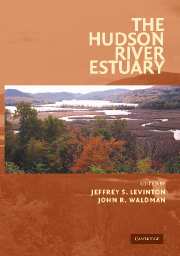Book contents
- Frontmatter
- Contents
- Preface
- List of Contributors
- The Hudson River Estuary
- 1 The Hudson River Estuary: Executive Summary
- GEOLOGICAL, PHYSICAL, AND CHEMICAL SETTING OF THE HUDSON
- PRIMARY PRODUCTION, MICROBIAL DYNAMICS, AND NUTRIENT DYNAMICS OF THE HUDSON
- HUDSON RIVER COMMUNITIES, FOOD WEBS, AND FISHERIES
- 12 Larval Migrations Between the Hudson River Estuary and New York Bight
- 13 The Diadromous Fish Fauna of the Hudson River: Life Histories, Conservation Concerns, and Research Avenues
- 14 Fisheries of the Hudson River Estuary
- 15 The Role of Tributaries in the Biology of Hudson River Fishes
- 16 Ecology of the Hudson River Zooplankton Community
- 17 Submersed Macrophyte Distribution and Function in the Tidal Freshwater Hudson River
- 18 Long-Term and Large-Scale Patterns in the Benthic Communities of New York Harbor
- 19 The Benthic Animal Communities of the Tidal-Freshwater Hudson River Estuary
- 20 Tidal Wetlands of the Hudson River Estuary
- 21 Alien Species in the Hudson River
- CONTAMINANTS AND MANAGEMENT ISSUES OF THE HUDSON RIVER ESTUARY
- Index
- Plate section
- References
13 - The Diadromous Fish Fauna of the Hudson River: Life Histories, Conservation Concerns, and Research Avenues
Published online by Cambridge University Press: 06 January 2010
- Frontmatter
- Contents
- Preface
- List of Contributors
- The Hudson River Estuary
- 1 The Hudson River Estuary: Executive Summary
- GEOLOGICAL, PHYSICAL, AND CHEMICAL SETTING OF THE HUDSON
- PRIMARY PRODUCTION, MICROBIAL DYNAMICS, AND NUTRIENT DYNAMICS OF THE HUDSON
- HUDSON RIVER COMMUNITIES, FOOD WEBS, AND FISHERIES
- 12 Larval Migrations Between the Hudson River Estuary and New York Bight
- 13 The Diadromous Fish Fauna of the Hudson River: Life Histories, Conservation Concerns, and Research Avenues
- 14 Fisheries of the Hudson River Estuary
- 15 The Role of Tributaries in the Biology of Hudson River Fishes
- 16 Ecology of the Hudson River Zooplankton Community
- 17 Submersed Macrophyte Distribution and Function in the Tidal Freshwater Hudson River
- 18 Long-Term and Large-Scale Patterns in the Benthic Communities of New York Harbor
- 19 The Benthic Animal Communities of the Tidal-Freshwater Hudson River Estuary
- 20 Tidal Wetlands of the Hudson River Estuary
- 21 Alien Species in the Hudson River
- CONTAMINANTS AND MANAGEMENT ISSUES OF THE HUDSON RIVER ESTUARY
- Index
- Plate section
- References
Summary
abstract The Hudson River hosts almost a dozen diadromous fishes – species that migrate between marine and fresh waters. Only one, American eel, is catadromous (spawn at sea); the remainder are anadromous (spawn in fresh water). American shad, Atlantic sturgeon, and striped bass have been subjected to large, long-term, commercial fisheries; striped bass also support an intensive recreational fishery. Because of protection afforded the coastal migratory mixed stock of striped bass, the Hudson's population is high at this time. Among Hudson River finfish, only American shad have low enough body burdens of polychlorinated biphenyls (PCBs) to allow commercial harvests today, but this stock has shown a long-term decline. Because of late twentieth century commercial overfishing of the Hudson River Atlantic sturgeon stock and the depleted status of most of its other populations, this species is being conserved under a fishing moratorium that may extend to 2038. The river's other acipenserid, shortnose sturgeon, was one of the original taxa listed under the 1973 U.S. Endangered Species Act; there is evidence that its abundance has multiplied four-fold since then. Marine-migrating blueback herring have colonized the Mohawk River – thus extending their distribution and increasing their abundance in the system. Two cold-water fishes at the southern margin of their ranges have become apparently extinct (rainbow smelt) or have shown declines (Atlantic tomcod) that may be related to warming. Recent studies have increased knowledge of the Hudson's diadromous ichthyofauna, but many questions remain, particularly concerning the effects of non-native species and shifting community compositions. Opportunities exist to mitigate some population declines through habitat enhancement.
- Type
- Chapter
- Information
- The Hudson River Estuary , pp. 171 - 188Publisher: Cambridge University PressPrint publication year: 2006
References
- 8
- Cited by



